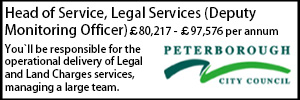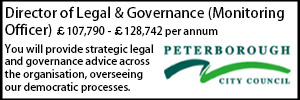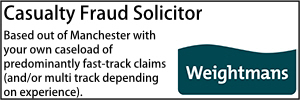Reviewing legal services expenditure
 Helen Edwards looks at the steps public sector bodies can take to get the most out of their spend on legal services.
Helen Edwards looks at the steps public sector bodies can take to get the most out of their spend on legal services.
- Details
We all know that public sector organisations budgets are being squeezed, with savings needed in all areas. Legal Services are no exception. Whilst it is virtually impossible to avoid some spend on legal services organisations are increasingly seeking to minimise it and maximise value for money at every possible turn.
When potential clients approach us for assistance in reducing their legal costs, one of our first questions is to ask how much the organisation currently spends. Perhaps surprisingly, hardly anyone is able to answer this question; their organisations have simply not recorded detailed information, and any information that exists is often patchy and spread across different departments. It is, obviously, still possible to make recommendations where efficiencies and savings might be made, but the organisation is not able to confidently understand exactly how much it might save, without reliable base line costs data. It could be argued that this is not important, and that what really matters, is that savings, no matter how large or small, are still possible.
Yet I would counter that it matters very much! Firstly to ensure that savings opportunities are fully identified and maximised, and secondly to enable the person responsible for legal services expenditure, to be able to evidence the contribution that they have made to overall savings targets.
Anyone working in an organisation where they are under pressure to “do their bit”, will recognise how important that is for them personally, but it is important for the organisation too, to ensure that savings targets are allocated appropriately and in a way which still enables the organisation and its services to function properly. So, when an organisation approaches us for assistance in reducing legal costs, we will usually recommend a review of expenditure, to identify areas of inefficiency, savings opportunities, and to develop a focused improvement plan capable of delivering sustainable and measured savings.
Identifying total expenditure on legal services
The first step is to identify all legal expenditure within the organisation. If there is an in-house legal department, the starting point will be to understand the costs of that team. However, even with an internal team, some legal services budgets are probably held in other departments. It is not uncommon, for example, for the Housing Management Team in a Housing Association to be responsible for the disbursements budgets for court proceedings, and this may be substantial. It may also be complicated to extract information about legal costs, because the financial systems are often not sufficiently sophisticated to allow them to be easily identified. This will inevitably require the involvement of the Finance team, and even then, there may be difficulties depending on how expenditure is coded.
In an organisation that does not have an internal legal team, it may be even more complicated to identify legal costs. This is because they are usually paid directly from the budget of the separate departments in the organisation, and in many organisations legal costs are not recorded separately. Again, the Finance department will need to be involved in identifying the overall spend.
Whether or not there is an internal legal team, depending on the way that an organisation is structured, some costs that might properly be described as legal services expenditure could sit within client departments. If any legal services processes are carried out in the client department, they ought to be included; for example, if the Finance department issues court proceedings for unpaid invoices, this should be included in legal services expenditure.
Identifying what the organisation gets for its money
Identifying total legal services spend might be a challenge, but even then, it is only a part of the equation. The next stage is to identify what the organisation is getting in return for its money. The quality of performance management information across organisations differs greatly. Some have really got to grips with the importance of this, others have progressed more slowly.
There is little that can be done to recreate historical data if it has not been routinely collected, but the review should identify the adequacy, or otherwise, of the information that is available, and provide an ideal opportunity to put arrangements in place to assess future performance. The position is similar in relation to benchmarking. There are many benchmarking opportunities, but they differ in value, depending on how comparable the information is. If an organisation does not have reliable benchmarking data, it should be encouraged to join existing benchmarking clubs that might provide reliable data, or alternatively consider setting up its own benchmarking club with similar organisations. It may be more valuable to compare information with a smaller number of similar organisations, than to access larger benchmarking clubs, where the value of the comparative data might be diluted if the organisations taking part are too dissimilar.
Reviewing costs of external legal services provision
The costs of legal services provided by external suppliers will often be substantial, even if there is an in-house legal team. Some organisations exercise more control over external suppliers than others, and it may be difficult to identify the total cost. The starting point should be to identify all external legal suppliers used. This should be more straightforward if the organisation uses a framework agreement, but even then, there may be some off panel spend. All those instructing externally should be asked for details of who has been instructed, on what matters, and the costs that have been incurred.
Once the data has been collected, it should be possible to review this expenditure, taking into account the following factors:
- If there is no framework agreement in place, how many different suppliers have been used, and for what types of work?
- If a framework agreement exists, is it being used, and is there good reason for any off panel instructions?
- Has any internal process for instructing off panel been followed?
- If the framework has been used, have fixed or capped rates been agreed? (hourly rates should be the exception, not the norm)
- Has the lowest priced supplier been used?
- Would it have been possible to obtain better rates through a mini-tender?
- Do invoices accord with agreed fees or estimates? If not have satisfactory explanations been given?
- What are the reasons for the work being given to external suppliers, and could it have been done cheaper internally?
The information provided through this review should enable the organisation to assess whether it is using its external suppliers to best effect, and whether improvements might be made. Possible steps to take to improve efficiency may be to establish a panel of suppliers through a framework agreement, if one does not already exist, or to improve panel management if there is a framework that is not being used to best effect.
There may be a case for outsourcing more, or different types, of legal work, or conversely, insourcing some of the work that is currently outsourced. In addition, the availability of fixed fee arrangements should be reviewed. These are one of the most effective ways of gaining control over legal expenditure. If fixed fee arrangements have not already been agreed, then this should be considered, and if arrangements are in place the organisation should check that it is using them to optimum effect. If additional hourly rates are regularly charged over and above agreed fixed fees, then they need to be reviewed with the suppliers. All of these issues can be explored further if the outcome of this element of the review suggests that it might be a worthwhile project.
Reviewing the cost of internal legal services provision
Reviewing internal legal services costs may be more challenging, as it may lead to the conclusion that the internal team needs to be restructured. Organisational change often leads to a period of uncertainty, and even the process of review may unsettle some employees; the organisation needs to balance the potential disruption against the potential improvements, and choose the best time to carry out this review.
It should be relatively simple to work out the cost of employing the internal legal team, as this will be in the organisation’s budget. Some issues may be caused by the way in which internal overheads are recharged, but once this is understood, it should be possible to establish a reasonably clear picture.
In addition to benchmarking and general performance management information collected by the organisation as a whole, it should be possible to obtain more data specifically in respect of the internal legal team. This is easier if there is a case management system that keeps detailed time recording information against case files. It becomes more problematic with less sophisticated (or non-existent) case management systems. Ideally, this review should be able to show:
- The number of hours each employee works on case work (rather than general administration, team meetings, and so on);
- The number of hours a particular type of case typically takes;
- The average number of employees working on a case;
- The grade of employee working on a matter;
- Average cost per case, per work type.
If this information is not readily available through the case management system, it is possible to create it, but that obviously takes more time and effort. It can be done by talking to the individual employees to find out general information about the way in which they work, and then putting in place systems to record the necessary information over a period of time.
The data obtained from this exercise should enable an organisation to review not only the costs of the internal team, but also its structure. The two are inextricably linked, as costs will be higher if the team is not optimally organised, and few teams are, as their structure is influenced by many factors. Indeed, some of those factors may prevent an organisation from making immediate changes that might otherwise bring efficiencies, but that ought not deter the organisation from considering how best to deliver its internal legal services Factors to consider include:
(i) Whether work is being carried out at the correct level. For example: are qualified lawyers doing work that could be done by a paralegal? Could employing more administrative staff free up more time for lawyers and paralegals to do work that requires legal input? Could it be more cost effective for employees at different levels to work together on the same case?
(ii) If there are sufficient numbers of employees at each level;
(iii) How the administrative support to the legal team is provided, and whether the ratio of lawyers to support staff is appropriate;
(iv) Which types of work could be standardised;
(v) Would it be more cost effective to outsource some types of work;
(vi) Would it be more cost effective to insource some types of work that are currently outsourced;
(vii) Whether more specialists are needed in certain areas, and if so, what is the most cost effective way of sourcing them? Could a specialist lawyer be shared with another organisation?
(viii) Are different ways of working, such as setting up a shared service, worth exploring;
(ix) Whether there are any opportunities to trade, to take advantage of spare capacity or particular expertise in a certain area of work;
(x) What overheads are incurred by the team, and is there any opportunity to influence them?
If a full review of legal services expenditure is carried out, the potential information that it can reveal is very powerful, and could allow an organisation to totally transform the way it handles its business, to maximise efficiencies. Not all organisations will immediately be ready for such transformation, but that should not discourage them from carrying out the exercise. Transformation can be brought about quickly, or can be achieved through a longer- term programme, with only “quick wins” being introduced initially.
Whatever approach is taken, I would strongly advise all organisations to carry out some level of review of its legal services expenditure, so that it understands how much it is spending, and on what. After all, if you do not understand it, how can you hope to control it!
Helen Edwards is Head of the Public Sector Team at Kennedy Cater.
Kennedy Cater works with a wide range of private and public sector clients, managing an aggregate annual external legal spend in excess of £20m. Services include:
- Spend & Review Services –detailed analysis and identification of sustainable savings and efficiency opportunities
- Alternative Business Models – business cases and implementation project management
- Panel Set Up – EU compliant solicitor and barrister frameworks
- Panel Management – monitoring, analysis and reporting of monthly fees
- Insourcing – in house team business cases and implementation project management
- Contract Management – mini tenders and management of complex and large legal services projects
- Benchmarking – comparing key costs of service delivery with similar organisations.































